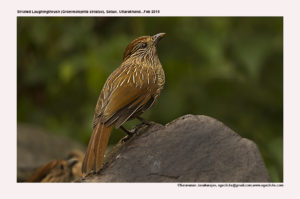Straited Laughingthrush

Striated Laughingthrush Garrulax striatus
Etymology:
- Garrulax : Latin word garrulous –babbling, chattering; ax – inclining towards
- Striatus :Latin word striatus –striated
Vernacular names: Paharia: Bhiakura, Cachar: Daopa,Lepcha: Nampiok-pho, Bhutia: Kopiam
Distribution in India: Resident of Himalayas and North East in India.
Description: Size of 26-28 cm: wt. of 123–148 g. It is a large, bulky laughingthrush, brown with thin white streaks, bushy crest and stout bill. The nominate race has crown chestnut, with feathers long, broad and erectile in floppy crest. The upperparts are dull rufescent brown with bold white shaft streaks, wing fringes and tail dull rufescent brown. The head side from above eye to chin and throat ischestnut-chocolate with bold whitish shaft streaks. The upper breast and neck side are similar but paler, mid-breast to lower underpartsare buffy with long white streaks, dirty ochrous on lower flanks, thighs and vent. The iris is brownish-pink to dull brick, orbital skin is plumbeous, bill blackish-brown or dark horn, the lower mandible is paler and the legs are dull bluish-slate to greyish-brown. Both the sexes are similar. The juvenile is warmer above than adult, streaks on underparts are narrower and fainter.Races found in India are Nominate (Himachal Pradesh and Uttarakhand), racebrahmaputra (Arunachal Pradesh) is duller-crowned , crown is less streaked and with broad blackish-brown lateral crownstripe, paler upperparts with more obvious paler dull rufous-brown to olive-brown fringing, less pronounced streaking, more contrasting breast-feather pattern, less pronounced streaking below.
Habitat: It is found in broadleaf evergreen forest, secondary forest, scrub-jungle, thickets, bamboo and wooded patches around villages. It is found at 600 to 3060 m.
Food habits : It eats Insects, including beetles; berries and seeds, aromatic wintergreen, flowers and rhododendron, and gelatinous lichen. It is more arboreal than most laughingthrushes. It forages mainly in middle storey to lower canopy, feeding in canopy of tall trees as well as in lower branches and undergrowth. It is found singly, in pairs or in parties of 5–8 individuals, often in association with other laughingthrushes and often at fruiting trees.
Breeding habits: They breed in Apr–Aug in Himalayas. The nest is a broad, shallow, strongly made cup, of coarse grasses, twigs, creeper stems, rootlets, dead leaves, green moss and green fern fronds, lined with coarse roots, fine black roots and dry grasses, placed above ground in sapling, branches of larger tree or among climbing plants. They lay a clutch of 2–3 eggs. The incubation is done by both sexes.